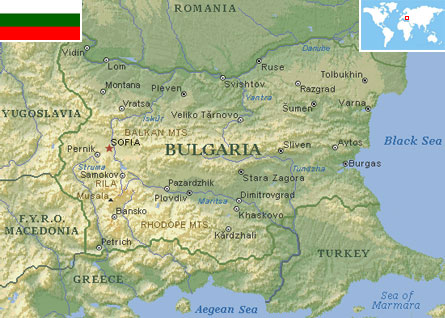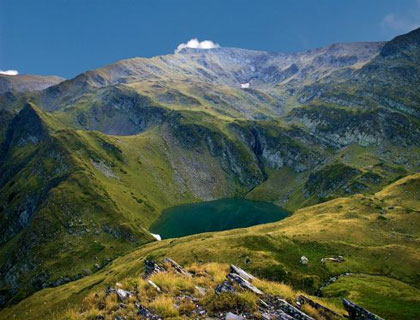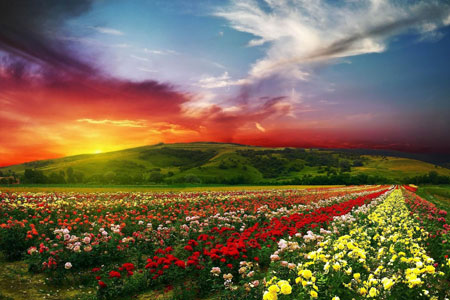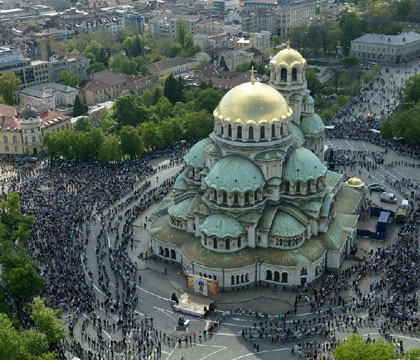Bulgaria
Country statistics

Land area: 42,683 sq miles (110,549 sq km)
Total area: 42,823 sq miles (110,910 sq km)
Population (2011 est.): 7,093,635 (growth rate: -0.781%); birth rate: 9.32/1000; infant mortality rate: 16.68/1000; life expectancy: 73.59
Capital City:
Monetary unit:
Languages: Bulgarian 85%, Turkish 10%, Roma 4%
Ethnicity/race: Bulgarian 83.9%, Turk 9.4%, Roma 4.7%, other (including Macedonian, Armenian, Tatar, Circassian) 2% (2001)
Religions: Bulgarian Orthodox 83%, Islam 12%, other Christian 1% (2001)
Country introduction

Bulgaria is a country located in South-eastern Europe and borders Romania to the North, Serbia and Macedonia to the west, Greece and Turkey to the south and the Black Sea to the east.
Bulgaria has a varied relief consisting of extensive lowlands, plains, hills, low and high mountains, many valleys and deep gorges. The main characteristic of Bulgaria's topography is alternating bands of high and low terrain that extend east to west across the country. The Danube Plain spreads to the north while the Valley of Roses and the Thracian lowland are to the south.
The country is dotted by hundreds of lakes and springs and the largest river is the Danube. Bulgaria also boasts 260 glacial lakes along with over 2,200 dam lakes. There is an abundance of mineral springs across the country, many of which are tourist attractions where people can bathe in the healing waters. Bulgaria is also renowned for its wealth of natural parks and reserves.
More than a half of the country's territory is covered by hills and mountains. The Balkan Mountains crosses the country from the north-west up to the Black Sea and forms the watershed between the Danube and the Aegean Sea. The Rhodope Mountains lie to the south and matches the border with Greece. In the south-west the highest mountain in Bulgaria and the entire Balkan Peninsula, Rila is located, with the highest peak being Musala at 2,925 m. The mountains Sredna gora in the central part of the country, Strandzha and Sakar in south-eastern Bulgaria, and Osogovo in south-western Bulgaria are lower but they are picturesque as well and preserve beautiful nature.
The Bulgarian seacoast is also very attractive. About 25% of the coast line is covered with fine golden sands and many remarkable sea resorts attract numerous tourists.
The culture

Bulgaria has had a fine heritage of ancient civilizations and had seen the presence of the Thracians, the Greeks and Romans and then the Slavs, all who left their mark by contributing to the unique folklore and fine literature of the country. For thirteen centuries it was the cradle of Slav culture, had produced men such as Spartacus in the land of Orpheus, who made brilliant contributions to the world and many examples of ancient applied arts were discovered in the form of magnificent frescos, burial tombs and Thracian treasure.
Bulgarian festivals and customs date back to ancient times when men tried to appease the natural elements and trembled before their power. Bulgarian folklore is full of beauty, gaiety, mystical voices, fiery dances and brightly colored costumes. Fire dancing is the most ancient mysterious ritual where barefooted dancers perform on burning embers to expel illnesses and to increase health and fruitfulness. Bulgaria is one of the biggest producers of rose oil in the world and it is a symbol of the country, because of this reason the Festival of Roses is celebrated on the first weekend of June every year in the Rose Valley near the town of Kazanlak (at the foot of the Balkan Range). Kukeri Carnival held in the region of Dupnitsa and Pernik is a splendid festival of brightly colored masks and costumes which marks the beginning of the spring. Every participant makes his own multi-coloured personal mask, covered with beads, ribbons and woollen tassels to scare away evil spirits. The most famous folklore festivals in Bulgaria are the "Rozhen Sings" and "Pirin Sings". Nearly 4,000 performers take part in each of these festivals and over 150,000 visitors from abroad and Bulgaria witness these festivals.
Bulgaria has a rich heritage in the visual arts, especially in frescoes, murals and icons. The Thracian Tomb of Kazanlak offers fine examples of excellently preserved ancient Thracian art. Tomb art provides one of the most important sources of information about Thracian lifestyle and culture. Applied crafts have also emerged through cultural traditions and include embroidery with its intricate geometrical figures, rugs and carpets with their vibrant colours, exquisitely painted ceramics, finely ornamented fretwork and superbly fashioned jewellery. The Samovodene Market in Veliko Turnovo, the Permanent National Exhibition of Folk Art in Oreshak near Troyan and the Etura architectural and ethnographic complex near Gabrovo are all original museums of the revived beauty of Bulgarian handicrafts.
Attractions & landmarks

Bulgaria is known for its exceptionally beautiful scenery that includes high mountains, dense forests, caves, lakes, springs, rivers and coasts with beautiful beaches. With thousands of historical, archeological, architectural, natural landmarks and travel hot spots, Bulgaria offers unlimited and incredible opportunities for tourism.
Bulgaria's main attraction is its long, sandy Black Sea Coast, which possesses many stunning beaches and picturesque bays. White and golden sandy beaches occupy approximately 130 km (80 miles) of the 378 km (234 miles) long coast that attracts millions of foreign and local tourists during the summer season from May to October.
Bulgaria is distinguished for its beautiful nature with vast areas preserved into natural reserves and national parks. The most extensive park is the Pirin National Park, which covers an area of 26,480 hectares. Over 60% of its territories are covered by woods and here is the location of the oldest tree in Bulgaria, a white fir of over 1200 years. The park is inhabited by bears, lynx, rare birds and other kinds of wildlife that are now becoming scarce elsewhere in Europe. There are also over 50 peaks located at more than 2,600 m (8,530 ft) above sea level and approximately 70 lakes dating back to the Ice Age. The great number of beautiful waterfalls, caves and imposing precipices lend charm to the magnificent landscape. The ecological balance of the area, the unique flora and fauna, the first-class tourist base and the authentic folklore of the region create an excellent condition for rest and sport.
Bulgaria's capital and its largest city, Sofia, which is situated 150 km (93 miles) north from the park, contains many valuable monuments from its long and storied past. The city was founded by the Thracians and was called Sardica, then in 500 BC the Odrysi tribe came to rule over the city, but it was not lasting and from 4th century BC came under the rulership of Philip Macedon and his famous son Alexander the Great. Then there were the Romans, Bulgarians, Turks and Russians. Through all this, the city of Sofia preserved many monuments and buildings of different epochs, which today attract many visitors each year. Among the most outstanding attractions is the Alexander Nevsky Cathedral, which is considered a symbol of Sofia and even Bulgaria. The main entrance of the cathedral is decorated with marbles, with mosaics above the doorways, and the domes are laden with 8 kg of gold. The cathedral can take 5,000 people and the interior is stunningly and richly decorated with the best materials imported from overseas including Italian marble in various colours and Brazilian onyx. The oldest church in Sofia is the Saint George Rotunda. It is thought that the church was built in the 6th century, during the reign of Constantine the Great. In the midst of the city's religious landmarks, directly across from The Presidential Palace, is The National Archeological Museum, which has in its collection some of the most valuable treasures discovered in Bulgaria. Masterpieces of Bulgarian painting are also on display at The National Art Gallery, located in what was formerly the Bulgarian Royal Palace. The National Museum of Ethnography is also located here, and The Museum of Natural History is a very short distance away, with exhibits of plants and animals that are very valuable, and even some that can no longer be seen in the wild.